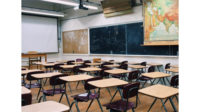Racine, Wis. — With recent Canadian wildfires creating smoke that has blanketed significant portions of the U.S., Modine is offering free Needlepoint Bipolar Ionization to schools for a limited time.
The offer is available with any scheduled service performed by a dedicated Airedale by Modine field technician in select regions affected by the current wildfires, the company said in a press release. Modine also recommends best practices schools can follow to provide students with healthy air and combat air pollution.
“The recent wildfires have created dangerous air quality situations for communities across the east coast,” said Kimberly Raduenz, manager of strategic marketing for Modine’s IAQ division. “According to a report by Reuters, this situation marked the worst outbreak of wildfire smoke to blanket the Northeastern U.S. in more than 20 years. In some areas, the air quality index was well above 400, which is considered hazardous.
“At Modine, we pride ourselves in providing solutions that can provide K-12 schools with the necessary tools they need to combat serious IAQ issues, such as that caused by the wildfire smoke,” Raduenz continued. “That’s why it’s important to let school leaders, and the community at large, know about the solutions they can lean on to provide healthy air. Needlepoint Bipolar Ionization is just one solution that can create clean air.”
Modine has partnered with Global Plasma Solutions (GPS) to bring the Needlepoint Bipolar Ionization (NPBI) technology to Modine products with an easy-to-install retrofit kit. This technology produces a high concentration of positive and negative ions, delivering them to the space via the ventilation system. The ions attach to smoke particles, where they combine, becoming larger and thus more easily filtered from the air.
In addition to NPBI, Modine recommends the following actions to help improve IAQ:
Upgrade filters where possible: Upgrading filters can increase protection against smaller particulates. Since the early stages of the COVID-19 outbreak, ASHRAE has recommended the use of MERV 13 filters, or higher if the equipment is compatible.
Install HVAC upgrades: In addition to improved filters and installing NPBI technology, for an extra layer of protection, school leaders and facility managers can also install additional air-cleansing upgrades. An example of this would be UV lights. These lights draw in untreated air and pushes it through a highly reflective chamber with an ultraviolet light, which inactivates bacteria and fungi.
Establish and maintain the optimal ventilation rate: This not only helps create comfortable air to breathe, but it also helps cycle dirty air outside of the building. According to the CDC, at least five air changes per hour in an occupied space are recommended.
Replace aging units: If the school’s HVAC unit is old and no longer operating at optimal capacity, summer is a great time to have it replaced. While a newer unit may have more upfront costs, the school will be saving money over time. Having the replacement installed during the summer will help ensure less downtime during the school year.







